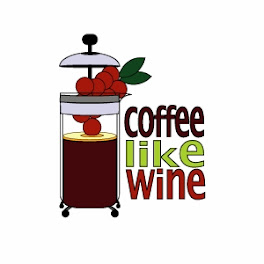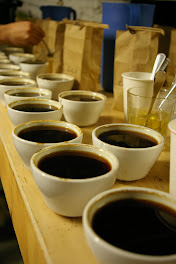I had a chance to speak with Edwin Martinez, a coffee exporter with Finca Vista Hermosa in Guatemala at the Slow Food tasting pavilion yesterday. He was hanging out at the coffee pavilion at Fort Mason in San Francisco. We had a really nice conversation about growing coffee beans and some of the exciting changes taking place among specialty coffee, and we tasted some amazing coffees as well.
Vista Hermosa, which means "beautiful view," took 8th place in the 2007 Cup of Excellence competition, with a jury score of 87.53, and sold its lot for $8.05 a pound. They didn't participate in the CoE this year, and the coffee station I visited at Slow Food wasn't pouring his coffee when I met him, though they did later on in the weekend.
One of the things I learned from him was that his farm has been sorting coffee by lots for decades now, but they've always combined them for buyers, who weren't interested in microlots of beans. Each microlot can produce coffee beans that reflect their specific and unique terroir, so by combining them into a blend, you loose their individuality. Barefoot Roasters' Andy Newbom, who was on the other side of the coffee tent, said he helped them sort, roast and cup their microlots in order to better separate the groups.
Edwin said in the past, if a coffee had a particularly striking taste (in a good way) buyers considered them defective and wouldn't want them. Starbucks used to buy his coffees, but with the way they roast, you wouldn't really see what they could be like. What a shame, and a waste of good beans. It gives you some idea why farmers had no incentive until recently to make an extra effort to cultivate superior beans.
I also learned that it's illegal(!) in Guatemala for coffee growers to naturally process beans (this is where they let the coffee cherry dry in the sun instead of washing the skin and mucus off the bean). The process can lead to uneven results and funky coffee beans when conditions are not ideal, which is why the country put that law into place. Though, he added, farmers still do process coffees that way, they just don't export them very far.
Despite the growing number of roasters who are seeking out single estate beans, Edwin said there's still a "huge gap" between the growers and consumers when it comes to coffee. He was hoping the Slow Food event would give drinkers a better idea of what coffee can be when carefully grown, roasted, and served fresh. From what I've read on his blog since the event, it seems like he was impressed with the people who organized and ran the coffee pavilion, and how the set up gave drinkers a chance to really experience how his efforts, and those of other farmers, can really make a difference in the cup. We both were blown away by the Ethiopian Beloya, a sun dried natural that was so sweet, with blueberry and cherry flavors. Think Jolly Rancher candy. It's hard to imagine how anyone could walk away from drinking that and not have a perspective-changing experience on coffee.
If you're interested in more info about Edwin's farm, you can take a tour and actually process some of your own coffee beans in March when they harvest. More info here.
Saturday, August 30, 2008
Subscribe to:
Post Comments (Atom)









No comments:
Post a Comment